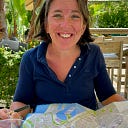Jabeur’s Year?
Tennis pundits are stuck on Nick, but Ons is the one to watch.
Kyrgios, Kyrgios, Kyrgios. Will Nick become the tennis player he is destined to be? To a lesser extent at this year’s Australian Open, Ash Barty faced the same chattering classes, aiming to become the first Australian woman in 42 years to win the home title.
Meanwhile, on the outer courts — where she is used to playing — then on Margaret Court and Rod Laver arenas, where she is not, Tunisian Ons Jabeur, an ‘old’ pro at age 25 whose ranking had slipped to 78 had something far greater to prove to a bigger continent: that she could become Africa’s tennis star, its hope on tour. But hey, no pressure.
“My phone is still going crazy right now,” Jabeur said at an AO press conference. “Actually, I talked to the president of Tunisia… He called me and told me that, even if there is a time distance, even if I am very far away, all of Tunisia is with me.”
It’s old news that Jabeur lost to the eventual Australian Open champion, Sofia Kenin. She did, however, become the first Arab woman in written history to advance to the quarter-finals of a Grand Slam tennis tournament. Kenin’s ultimate win eclipsed the feat for most sports writers — that and the eternal question of Nick Kyrgios’ ability — but on Monday, Jabeur also rose 33 spots to 45th in the latest WTA rankings, an all-time high for her, her country and her continent.
In the meantime, commentators who aren’t obsessed with Kyrgios, are wondering where Jabeur has been all along. “Is Ons Jabeur, who beat Qiang Wang yesterday to reach her first Grand Slam quarterfinal, a veteran? Or is she the Next Big Thing?” asked Steve Tignor on Tennis.com. “Like Andreescu, Jabeur can do anything with the ball, from anywhere on the court. She has the same blend of touch, power, and creative panache that have taken the young Canadian to the top of the sport, and, if anything, her shots are more fluid.”
Very true, but a bit unfair to diminish Jabeur’s talent. Jabeur can stretch for volleys far beyond the constraints of her arms, dive for drop shots, run down an overhead, slice a soft floater off a 70mph forehand and pop off unsuspecting aces against the likes of Johanna Konta, Caroline Garcia, Caroline Wozniacki and Qiang Wang — her draw at the Australian. And anyone who has combed the back courts to watch upstarts from uncommon countries, she is known to be gracious to her fans and her fellow players, offering post-match embraces to opponents — and ignore Coco Vandeweighe when she alludes to American dominance on Arthur Ashe.
“I’m… trying to inspire many generations back home,” Jabeur said. “Either in Tunisia or the Arabic world, or especially in Africa.”
Jabeur still has a way to go professionally, even though she is in the vanguard of players from the Middle East and Africa who continue to popularize tennis in a region where for decades women were sequestered from sport. While tournaments in Qatar, Dubai, Morocco and elsewhere have increased the profile of tennis in Islamic states, female players also still have to question why more women like them aren’t in the draws and why more of the tournament purse money isn’t going to their junior programs.
But for the junior 2011 French Open champion, who admittedly looked for quick success on the professional tour, the long ride may make the victories sweeter — or at least, more motivational.
“So many players I played with in juniors, I see them, they’re like top 50, top 20,” Jabeur said. “To be honest, even if I didnt go to the quarters, I was still looking to myself to win a Grand Slam, but now I think I am more close and it’s even more in my dream.
“I think it could be a good start of the year to believe in things.”
